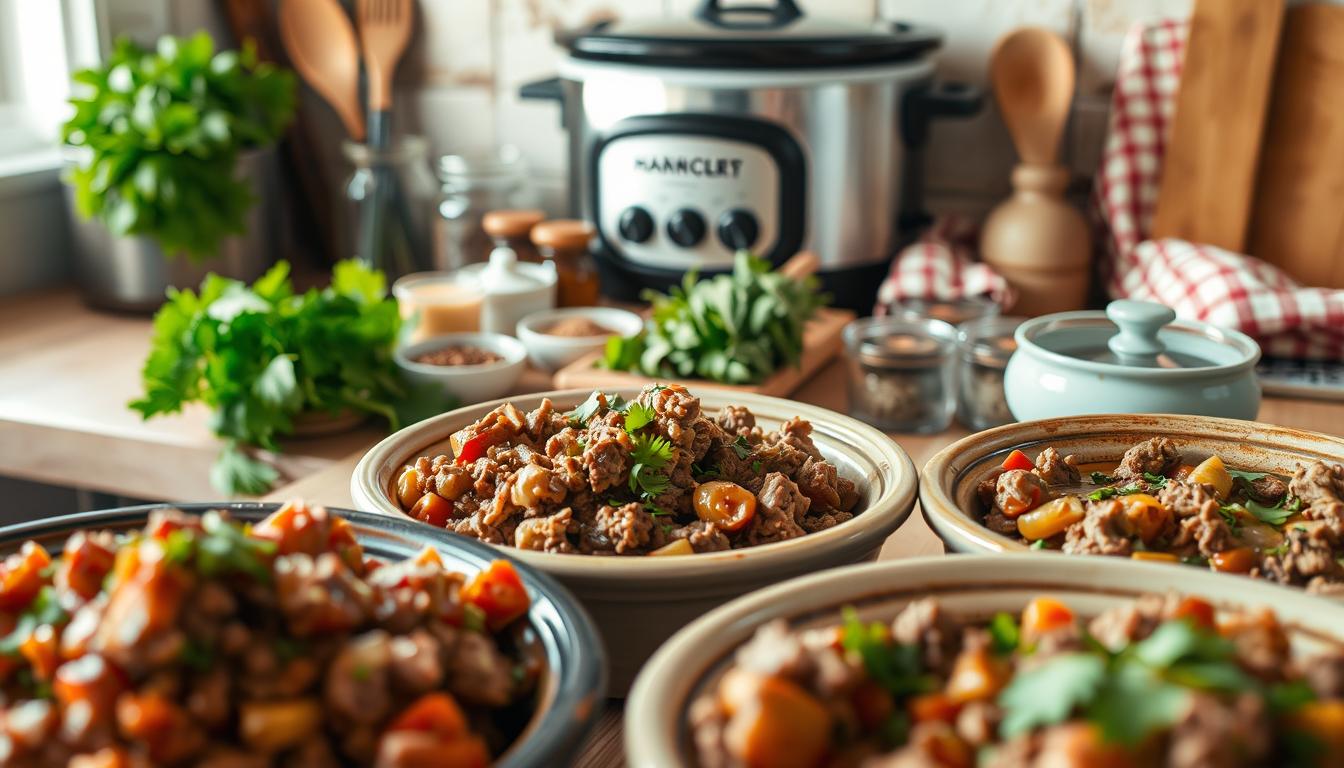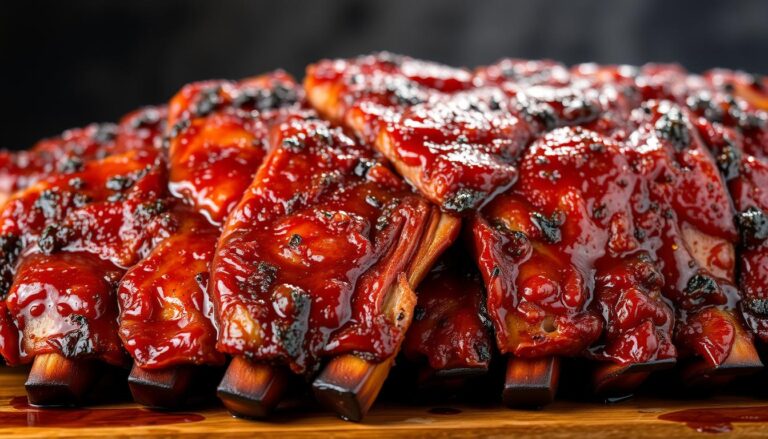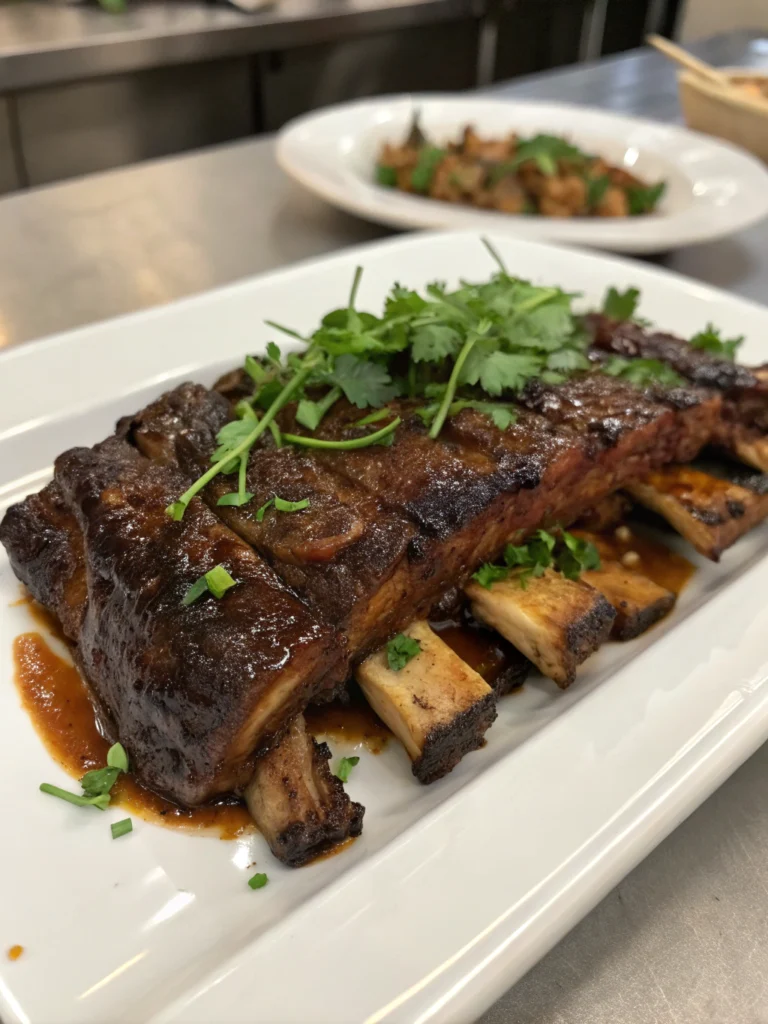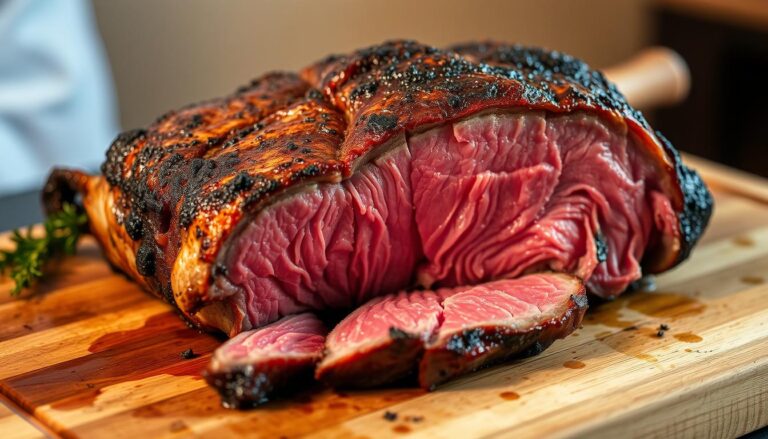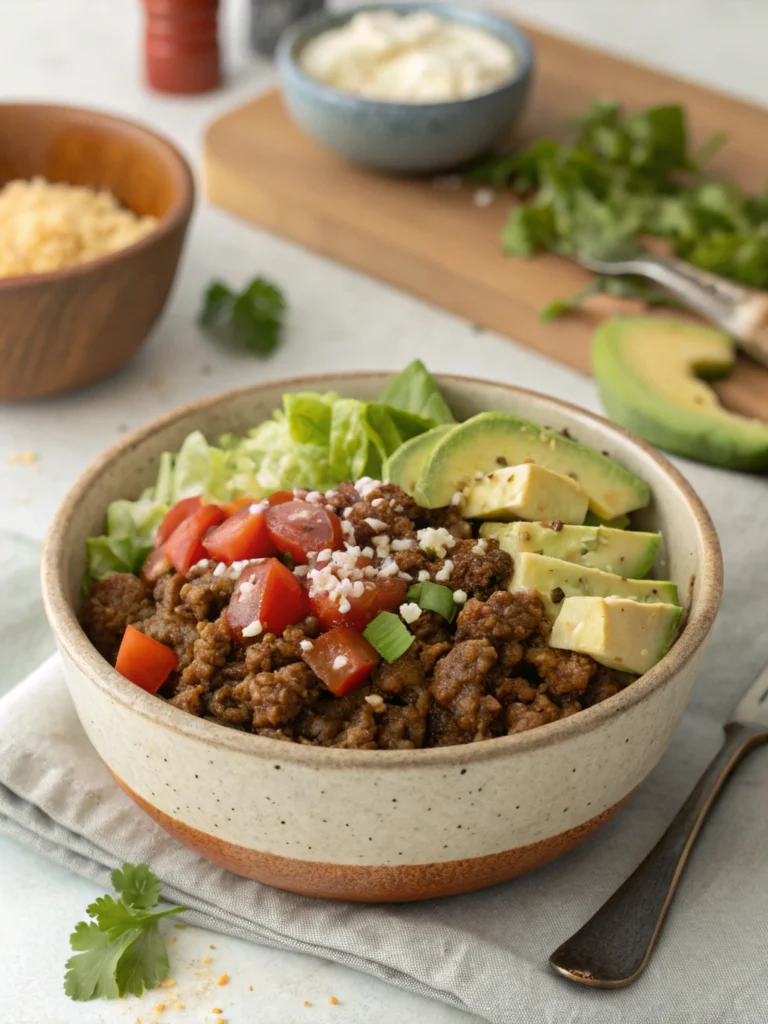Delicious Ground Beef Slow Cooker Recipes
Have you ever wondered how to create mouthwatering meals with minimal effort? Imagine coming home to a kitchen filled with the aroma of a perfectly cooked dish, ready to serve. With the right techniques and ingredients, this dream can become your reality.
This guide dives into the world of hearty, flavorful meals that are both convenient and satisfying. Whether you’re planning a weeknight dinner or preparing for a family gathering, these ideas will transform your cooking experience. From classic favorites to creative twists, you’ll discover how to make the most of your kitchen tools.
Drawing inspiration from trusted sources, this article offers step-by-step instructions, practical tips, and innovative ideas. You’ll learn how to balance convenience with taste, ensuring every meal is a hit. Get ready to elevate your culinary skills and impress your loved ones with dishes that are as easy to make as they are delicious.
Key Takeaways : Ground Beef Slow Cooker Recipes
- Discover the best ways to create hearty meals with minimal effort.
- Learn how to balance convenience and flavor in your cooking.
- Explore classic dishes and creative twists for every occasion.
- Find practical tips and step-by-step instructions for success.
- Transform your weeknight dinners and family gatherings with ease.
Introduction to Slow Cooker Cooking with Ground Beef
Transform your kitchen routine with the magic of slow cooking. This method turns simple ingredients into extraordinary meals with minimal effort. Whether you’re a busy parent or a culinary enthusiast, slow cooking offers a way to create flavorful dishes that impress.
Why Slow Cooking Is a Game Changer
Slow cooking uses low-and-slow heat to break down tough cuts of meat, making them tender and juicy. This process enhances the natural flavors of ingredients, creating a depth of taste that’s hard to achieve with other methods. For example, a simple dish like chili becomes rich and hearty when cooked slowly.
Pre-browning your meat before adding it to the slow cooker can elevate the flavor even further. This step caramelizes the surface, adding a layer of complexity to your dish. Layering ingredients also helps develop a well-rounded taste, ensuring every bite is satisfying.
Benefits of Using a Slow Cooker for Comfort Food
One of the biggest advantages of slow cooking is the convenience it offers. You can prepare your meal in the morning, let it cook throughout the day, and come home to a ready-to-serve dinner. This is especially helpful for busy households.
Here’s a quick comparison of slow cooking versus traditional methods:
| Aspect | Slow Cooking | Traditional Cooking |
|---|---|---|
| Time | Set and forget | Requires constant attention |
| Flavor | Deep and rich | Varies based on technique |
| Convenience | Ideal for busy schedules | Less flexible |
Real-life examples from trusted sources show how slow cookers have become indispensable in modern kitchens. From stews to casseroles, this method ensures every meal is both delicious and effortless.
Essential Ingredients for a Flavorful Meal
Crafting a flavorful meal starts with the right ingredients. The balance of vegetables, spices, and liquids can transform a simple dish into something extraordinary. Let’s explore the essentials that make every bite unforgettable.
Key Vegetables and Spices
Fresh vegetables like onions, carrots, and celery add both texture and depth to your dishes. Onions, in particular, are a staple for building a savory base. Their natural sweetness caramelizes during cooking, enhancing the overall flavor.
Spices and herbs are equally important. A pinch of paprika or a sprinkle of thyme can elevate your meal. Combining these with aromatic garlic or ginger creates a harmonious blend that complements the main ingredients.
The Role of Broth, Sauces, and Seasonings
Broth is the backbone of many hearty meals. Whether you use chicken, beef, or vegetable broth, it infuses your dish with moisture and richness. A robust broth can turn a simple stew into a comforting masterpiece.
Sauces, like tomato-based or cream varieties, add layers of complexity. They bind ingredients together and create a cohesive flavor profile. Seasonings, such as salt, pepper, and bay leaves, fine-tune the taste, ensuring every bite is balanced.
By carefully selecting and combining these elements, you can create meals that are both satisfying and memorable. The right ingredients are the key to unlocking the full potential of your cooking.
How to Choose the Right Ground Beef and Quality Ingredients
The foundation of a great meal lies in the quality of its ingredients. Selecting the best components ensures your dish is vibrant, flavorful, and satisfying. Let’s dive into the essentials for making the right choices.
When it comes to protein, opt for lean options with a balanced fat content. Freshness is key—check for a bright color and firm texture. Pairing it with the right tomato products, like crushed or diced varieties, can enhance the richness of your dish.
Vegetables like potatoes play a crucial role in adding texture and depth. Choose firm, unblemished ones for the best results. Supportive elements like cream-of-mushroom soup can add a layer of richness, tying all the flavors together.
“The quality of your ingredients directly impacts the consistency and taste of your sauce.”
Inspecting labels and sourcing fresh produce ensures every component elevates your meal. Look for organic or locally sourced options when possible. This attention to detail makes a noticeable difference in the final outcome.
By focusing on quality and technique, you can create dishes that are both delicious and memorable. The right ingredients are the building blocks of culinary success.
Step-by-Step Guide to Preparing Your Slow Cooker Meal
Mastering the art of slow cooking begins with the right techniques. A well-prepared meal is all about the details, from sautéing to layering flavors. Follow this guide to create a dish that’s rich, flavorful, and perfectly cooked.
Sautéing Beef, Onion, and Garlic
Start by heating a skillet over medium heat. Add a small amount of oil and your protein, breaking it into small pieces. Cook until browned, stirring occasionally. This step caramelizes the surface, adding depth to your dish.
Next, add finely chopped onions and minced garlic. Sauté until the onions are translucent and fragrant. This combination forms the base of your meal, infusing it with savory notes.
Layering Flavors for a Rich Sauce
Transfer the sautéed mixture to your slow cooker. Begin layering ingredients to build complexity. Add diced carrots and sliced peppers for sweetness and texture. These vegetables not only enhance flavor but also provide essential nutrients.
Pour in your choice of broth or sauce to create a rich base. Stir gently to combine all elements. This ensures every bite is packed with flavor.
Here’s a quick comparison of sautéing versus layering:
| Aspect | Sautéing | Layering |
|---|---|---|
| Purpose | Builds a flavorful base | Adds depth and complexity |
| Ingredients | Protein, onions, garlic | Vegetables, broth, spices |
| Technique | High heat, quick cooking | Low heat, slow melding |
By following these steps, you’ll create a meal that’s both delicious and satisfying. Whether you’re a beginner or a seasoned cook, these techniques ensure success every time.
Understanding Slow Cooker Settings and Cooking Times
Understanding your slow cooker’s settings can make all the difference in your cooking results. The right heat level and timing ensure your food is tender, flavorful, and perfectly cooked. Whether you’re using low or high heat, each setting has its unique benefits.
Low vs. High: What You Need to Know
Low heat is ideal for recipes that require longer cooking times. It gently breaks down tough cuts of meat and allows ingredients like vegetables to soften without losing their texture. This setting is perfect for dishes that need to simmer slowly, such as stews or braises.
High heat, on the other hand, is great for faster cooking. It’s useful when you’re short on time but still want a rich, flavorful meal. However, it’s important to monitor your dish to prevent overcooking, especially with delicate ingredients.
Here’s a quick guide to help you decide:
- Low Heat: Best for tenderizing meat and blending flavors over several hours.
- High Heat: Ideal for quicker meals or when you need to reduce cooking time.
Adjusting cooking times based on the type and quantity of ingredients is crucial. For example, adding a touch of sugar can enhance the sweetness of your dish, but it requires careful timing to avoid burning. Similarly, spices need time to infuse into the food for maximum flavor.
To avoid common pitfalls, always follow recipe guidelines and test your dish for doneness. With the right settings and timing, your slow cooker can transform simple ingredients into extraordinary meals.
Incorporating Vegetables: Potatoes, Carrots, and More
Vegetables like potatoes and carrots bring texture and depth to your dishes. They not only enhance flavor but also add essential nutrients. Proper preparation ensures they cook evenly and absorb the rich flavors of your meal.
Start by cutting your vegetables into uniform chunks. For potatoes, aim for 1-inch pieces. Carrots should be sliced into similar sizes. This ensures they cook at the same rate, preventing some pieces from becoming mushy while others remain undercooked.
Timing is crucial. Add tougher vegetables like carrots during the first hour of cooking. Softer ones, such as potatoes, can be added later to retain their texture. Layering ingredients also helps. Place vegetables at the bottom, allowing them to absorb the juices and spices.
“Properly timed and cut vegetables ensure every bite is balanced and flavorful.”
Here’s a quick guide to cooking times for common vegetables:
| Vegetable | Cut Size | Cooking Time |
|---|---|---|
| Potatoes | 1-inch chunks | 4-6 hours (low heat) |
| Carrots | ½-inch slices | 6-8 hours (low heat) |
| Onions | Diced | 2-3 hours (low heat) |
For a hearty dish, balance your vegetable quantity with protein. Use about 1 pound of vegetables for every 2 pounds of meat. This ratio ensures a well-rounded meal that’s both satisfying and nutritious.
By following these tips, you’ll create dishes where vegetables shine. They’ll be tender, flavorful, and perfectly cooked, adding both taste and texture to your meals.
Secrets to Creating a Rich and Tasty Sauce
Unlock the secrets to crafting a sauce that’s rich, flavorful, and unforgettable. A well-made sauce can transform any dish, tying all the ingredients together into a harmonious blend. Whether you’re making a hearty chili or a savory stew, mastering these techniques ensures every bite is packed with depth and complexity.
Balancing Spices and Tomato Elements
The foundation of a great sauce lies in the balance of spices and tomato elements. Start by sautéing onions and garlic to build a savory base. Add tomato paste or crushed tomatoes for acidity and richness. This combination creates a robust flavor profile that complements the meat and other ingredients.
Spices like cumin, paprika, and chili powder add warmth and depth. Be mindful of their intensity—too much can overpower the dish, while too little leaves it bland. Taste as you go, adjusting the seasoning to achieve a well-rounded flavor.
Thickening Techniques Using Slow Cooking
Slow cooking naturally thickens your sauce as it simmers. The low heat allows the liquid to reduce, concentrating the flavors. For a thicker consistency, add a slurry of cornstarch and water during the final hour of cooking. This method ensures your sauce clings perfectly to the meat and vegetables.
Incorporating broth gradually is another key technique. Start with a small amount, adding more as needed to adjust the consistency. This approach prevents the sauce from becoming too watery while maintaining its rich flavor.
“A perfectly thickened sauce enhances every component of your dish, making it a true culinary masterpiece.”
By mastering these techniques, you’ll create sauces that elevate your meals to new heights. Whether you’re cooking for a weeknight dinner or a special occasion, these secrets ensure every dish is unforgettable.
Exploring Global Variations on Slow Cooker Recipes
Expand your culinary horizons with global-inspired slow cooker dishes. From zesty Mexican flavors to hearty Italian classics, these recipes bring a world of taste to your kitchen. By blending traditional ingredients with innovative techniques, you can create meals that are both familiar and exciting.
Mexican-Inspired Flavors
Mexican cuisine is known for its bold and vibrant flavor profiles. A slow cooker taco soup is a perfect example. Start with a base of hamburger meat, browned and seasoned with cumin, chili powder, and paprika. Add 1 cup of corn, diced tomatoes, and black beans for texture.
Pour in 4 cups of chicken broth and let it simmer on low heat for 6-8 hours. The result is a rich, spicy soup that’s perfect for topping with avocado, cheese, and a squeeze of lime. This dish showcases how simple ingredients can create a flavor explosion.
Italian Twists Like Slow Cooker Lasagna
Italian cuisine offers comfort food with a twist. A slow cooker lasagna reimagines the classic dish by layering ingredients directly in the pot. Instead of traditional noodles, use lasagna sheets or even zucchini slices for a lighter option.
Start with a layer of hamburger meat mixed with 1 cup of marinara sauce. Add a layer of ricotta cheese, followed by a sprinkle of mozzarella. Repeat the layers, finishing with a generous topping of cheese. Cook on low for 4-6 hours, allowing the flavors to meld together.
| Cuisine | Key Ingredients | Cooking Time |
|---|---|---|
| Mexican | Corn, spices, black beans | 6-8 hours |
| Italian | Marinara sauce, cheese, lasagna sheets | 4-6 hours |
These global variations show how familiar ingredients can be reinvented in different culinary traditions. Whether you’re craving the flavors of Mexico or the comfort of Italy, your slow cooker can bring these dishes to life with ease.
Creative Side Dishes to Complement Your Main Course
Elevate your meal with sides that bring balance and freshness. A well-chosen side dish can enhance the flavors of your main course, adding texture and variety to your plate. Whether you’re serving a hearty dish or something lighter, these ideas will inspire you to create a complete dining experience.
Classic sides like spaghetti are always a hit. Pair it with a rich tomato sauce for a comforting combination. For a lighter option, try a robust salad with fresh greens, cherry tomatoes, and a tangy vinaigrette. These sides not only complement your meal but also add a pop of color to your table.
Here’s a quick guide to pairing sides with your main course:
| Main Course | Side Dish |
|---|---|
| Hearty stew | Garlic bread or mashed potatoes |
| Spicy chili | Cornbread or coleslaw |
| Savory casserole | Steamed vegetables or rice pilaf |
Quick-cooking methods make it easy to prepare sides without extra effort. For example, roasted vegetables take just 20 minutes in the oven. Toss them with olive oil, salt, and pepper for a simple yet flavorful addition. Similarly, a side of spaghetti can be ready in under 15 minutes.
“The right side dish can turn a good meal into a great one, balancing flavors and textures for a satisfying experience.”
For a creative twist, try adding unexpected elements to your sides. A sprinkle of Parmesan cheese on roasted veggies or a dash of chili flakes on garlic bread can elevate the dish. These small touches make a big difference in the overall flavor profile.
By incorporating these ideas, you’ll create meals that are not only delicious but also visually appealing. Whether you’re cooking for a family dinner or a special occasion, these sides will bring variety and freshness to your table.
Quick and Delicious “ground beef slow cooker recipe” for Weeknight Dinners
Busy weeknights call for meals that are both quick and satisfying. With the right approach, you can create a flavorful dish without spending hours in the kitchen. These recipes are designed for those hectic days when time is limited but taste is non-negotiable.
Start by gathering simple ingredients like celery, onions, and your choice of protein. These staples form the base of many hearty meals. Sautéing the celery and onions first adds depth to the dish, ensuring every bite is packed with flavor.
Here’s a step-by-step guide to a standout dish:
- Brown your protein in a skillet for added richness.
- Add chopped celery, onions, and garlic for a savory base.
- Transfer everything to your slow cooker and let it simmer on low for 4-6 hours.
Even on the busiest day, this method ensures a home-cooked meal with minimal effort. The slow cooker does the work, allowing you to focus on other tasks while dinner cooks itself.
“A well-prepared dish doesn’t have to be time-consuming. With the right ingredients and techniques, you can enjoy a hearty meal even on the most hectic day.”
By focusing on simplicity and quality, you can create meals that are both delicious and stress-free. These recipes prove that speed and flavor can go hand in hand, making weeknight dinners a breeze.
Adapting Recipes for Dietary Needs and Preferences
Cooking for dietary needs doesn’t mean sacrificing flavor or enjoyment. Whether you’re preparing a low-sodium or gluten-free meal, a few simple adjustments can make all the difference. With the right techniques, you can create dishes that are both healthy and delicious.
Low-Sodium and Gluten-Free Modifications
For low-sodium meals, swap regular broth for a low-sodium version. This small change reduces salt without compromising taste. Add fresh herbs like basil or thyme to enhance flavor naturally. These ingredients bring depth to your dish, ensuring each serving is satisfying.
Gluten-free adaptations are equally simple. Replace traditional pasta or flour with alternatives like quinoa or almond flour. These substitutes work seamlessly in most recipes, maintaining texture and taste. A pinch of spice can elevate the dish, making it a standout for any dinner.
“Adapting recipes to dietary needs ensures everyone can enjoy a flavorful meal, no matter their restrictions.”
Here’s a quick guide to common substitutions:
- Low-Sodium: Use low-sodium broth, fresh herbs, and citrus for flavor.
- Gluten-Free: Opt for quinoa, rice, or gluten-free pasta as alternatives.
By following these tips, you can create meals that cater to dietary needs without sacrificing taste. Whether it’s a family dinner or a special occasion, these adaptations ensure everyone can enjoy a delicious serving.
Meal Prep and Freezer-Friendly Slow Cooker Ideas
Streamline your week with easy meal prep strategies that save time and effort. Preparing meals in advance not only simplifies your routine but also ensures you always have a delicious option ready to go. With the right techniques, your slow cooker can become a meal prep powerhouse, helping you create hearty dishes that freeze well.
Batch Cooking Tips
Batch cooking is a game-changer for busy lifestyles. Start by choosing recipes that scale easily, like soups, stews, or casseroles. These dishes are perfect for making in large quantities and portioning for later use. When cooking, ensure your slow cooker is set to the right heat level to preserve flavor and texture.
Divide your meals into individual servings before freezing. This makes reheating quick and convenient. Use airtight containers or freezer bags to lock in freshness. Label each container with the dish name and date to keep track of your inventory.
Here’s a quick guide to batch cooking success:
- Choose recipes that freeze well, like chili or pasta sauce.
- Cook on low heat for even results.
- Portion meals before freezing for easy reheating.
“Properly stored meals retain their flavor and quality, making them a lifesaver on busy days.”
Freezer-Friendly Recipes
Explore creative ideas that are both hearty and convenient. A slow cooker lasagna, for example, can be assembled in advance and frozen in portions. When you’re ready to eat, simply thaw and reheat for a comforting meal. Another option is a vegetable-packed soup, which freezes beautifully and reheats without losing its comfort food appeal.
Here are some tips for freezing and reheating:
| Step | Best Practice |
|---|---|
| Cooling | Let dishes cool completely before freezing. |
| Storage | Use airtight containers to prevent freezer burn. |
| Reheating | Thaw in the fridge overnight for even heating. |
By incorporating these strategies, you’ll always have a stash of comfort food ready to enjoy. Whether it’s a busy weeknight or a last-minute dinner, freezer-friendly meals make life easier and tastier.
Inspirations from Trusted Slow Cooker Recipe Sources
Discover how trusted sources can elevate your slow cooking game. Brands like Dotdash Meredith and Allrecipes have become go-to resources for home chefs seeking reliable and delicious recipes. Their tested methods and user-approved dishes offer inspiration for every kitchen.
Highlights from Dotdash Meredith and Allrecipes
Dotdash Meredith Food Studios is known for its innovative approach to slow cooking. Their Salisbury steak recipe, for example, combines simplicity with rich flavors. By layering ingredients and using pre-preparation techniques, this dish saves valuable time while delivering a hearty meal.
Allrecipes, on the other hand, offers a treasure trove of user-tested recipes. Their slow cooker meatballs are a crowd-pleaser, praised for their ease and taste. These recipes often include tips for adapting to dietary needs or making them freezer-friendly, ensuring they fit seamlessly into busy lifestyles.
“The best recipes come from real-life experiences. Trusted sources like Allrecipes and Dotdash Meredith provide the guidance you need to succeed in the kitchen.”
Here’s a comparison of standout dishes from these sources:
| Source | Recipe | Key Feature |
|---|---|---|
| Dotdash Meredith | Salisbury Steak | Layering technique for depth |
| Allrecipes | Meatballs | Freezer-friendly and adaptable |
These examples showcase how trusted brands simplify cooking while maintaining quality. By following their lead, you can experiment with your own signature dishes. Whether you’re saving time or preparing meals for the freezer, these sources provide the tools you need to succeed.
Troubleshooting Common Slow Cooker Challenges
Are you struggling to keep your vegetables from turning mushy in the slow cooker? Overcooked veggies can ruin an otherwise perfect meal, but with the right techniques, you can maintain their texture and flavor. Let’s explore practical solutions to common slow cooker issues, ensuring every ingredient shines.
Preventing Overcooked Vegetables
One of the most common challenges is overcooking vegetables, leaving them soft and unappetizing. To avoid this, focus on proper prep and timing. Cut vegetables into uniform sizes so they cook evenly. For example, carrots and potatoes should be cut into 1-inch chunks.
Add tougher vegetables like carrots during the first hour of cooking. Softer ones, such as zucchini, should be added in the last hour. This ensures they retain their shape and texture. Layering ingredients also helps—place vegetables on top of the meat to prevent them from absorbing too much liquid.
“Proper prep and timing are the keys to keeping vegetables firm and flavorful in your slow cooker.”
Here are some quick tips to prevent overcooking:
- Use a timer to monitor cooking progress.
- Add delicate vegetables like spinach or peas in the last 30 minutes.
- Stir gently to avoid breaking down the texture.
By following these guidelines, you’ll ensure your vegetables are perfectly cooked every time. Whether you’re making a hearty stew or a zesty taco filling, these tips will elevate your dish.
Balancing Flavors and Textures
Another challenge is maintaining a balance between flavors and textures. Overcooking can lead to a bland or overly soft meal. To fix this, season your dish in layers. Add spices at the beginning for depth, and adjust seasoning at the end for a fresh burst of flavor.
For a well-rounded meal, pair your main dish with a fresh side. A crisp salad or steamed vegetables can complement the richness of slow-cooked dishes. This balance ensures every bite is satisfying and flavorful.
Here’s a quick guide to balancing your meal:
| Main Dish | Side Dish |
|---|---|
| Hearty stew | Garlic bread |
| Spicy taco filling | Guacamole or salsa |
By addressing these common challenges, you’ll create meals that are both delicious and visually appealing. With the right techniques, your slow cooker can become your go-to tool for perfect results every time.
Culinary Tips for Enhancing Flavor and Texture
Elevating your slow cooker meals to gourmet status is easier than you think. With a few expert techniques, you can transform simple dishes into memorable culinary experiences. The key lies in strategic seasoning and thoughtful finishing touches that bring out the best in every bite.
Seasoning Secrets and Finishing Touches
Seasoning is the backbone of any great dish. Start by layering flavors—add spices at the beginning for depth and adjust seasoning at the end for a fresh burst of taste. Fresh herbs like basil or parsley can elevate your meal when added just before serving. This ensures their vibrant flavor shines through.
Deglazing the pot is another technique to enhance richness. After sautéing, pour in a splash of broth or wine to lift the caramelized bits from the bottom. This creates a flavorful base for your sauce, adding complexity to every spoonful.
“Letting your dish rest before serving allows the flavors to meld together, creating a harmonious blend that’s both comforting and satisfying.”
Here’s a quick guide to seasoning techniques:
| Technique | Purpose |
|---|---|
| Layering spices | Builds depth and complexity |
| Deglazing | Adds richness to the sauce |
| Adding fresh herbs | Brings a vibrant finish |
For a crispy finish, consider broiling your dish for a few minutes after slow cooking. This adds texture and a golden crust that’s visually appealing. These small yet impactful steps ensure your meals are not only delicious but also a feast for the eyes.
By mastering these techniques, you’ll create dishes that impress both family and guests. Whether it’s a weeknight dinner or a special occasion, these tips will take your cooking to the next level, offering comfort and satisfaction in every bite.
Conclusion
Ready to transform your kitchen routine with minimal effort? This guide has equipped you with essential tips, techniques, and step-by-step processes to create hearty meals that impress. By experimenting with your pot, you can unlock deep, rich flavors that make every dish unforgettable.
Remember, the key to success lies in selecting quality ingredients and following proper cooking methods. Whether you’re cooking for a busy weeknight or a special occasion, these recipes are designed to fit seamlessly into your routine. Try them out this month and see how easy it is to enjoy delicious, home-cooked meals.
With the versatility of your pot, you’re now well-prepared to bring comfort and satisfaction to your table. Start creating your own signature dishes and make every meal a celebration of flavor and convenience.

